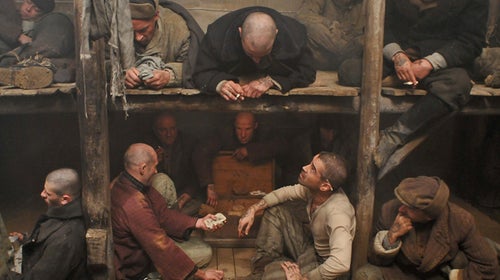THE WAY BACK is a movie about some guys who escape from a Soviet prison camp in Siberia and walk south for 4,000 miles and 12 months until they get to India. They endure blizzards, hunger, insects, desert heat, etc.; advised by Nepalese villagers to stay safely with them until spring, they press on and cross the snowbound Himalayas. Some die at difficult moments along the journey, but four of them survive. The movie is based on a book, The Long Walk, by Slavomir Rawicz, an as-told-to account published in England in 1956. The movie's accompanying press material acknowledges that most of the supposedly true story told in The Long Walk did not occur. Investigation by the BBC and others has shown that Rawicz's escape and long walk were made up, although he was in a Siberian prison camp and did go on a southward journey after his release. As the movie's poster declares, circumspectly, the movie was “inspired by real events.”
At this point I should warn that I am not a good person to watch movies with. Nowadays, movies have set aside all attempts at logic and common sense, and when I comment on examples of this during any particular movie, I am told to be quiet. Probably I should just be quiet about The Long Walk—described by Sebastian Junger as “one of the epic treks of the human race”—and about the equally far-fetched movie “inspired” by it. Ed Harris and his throbbing cranium portray the escapees' lone American, Mister Smith (no other first name given), the group's co-leader. Jim Sturgess plays the Rawicz character, the movie's main protagonist, the other leader. Colin Farrell plays a vicious, jackal-like career-criminal thief who eventually learns that all human beings must help one another in order to survive. Farrell's character is not in the book at all but seems to have been borrowed from the work of a far better writer, Varlam Shalamov, whose books Graphite and Kolyma Tales are among the great documents of the gulag. In Shalamov's books, the heartwarming lessons learned are few.
When you jury-rig a mostly made-up movie on top of a mostly made-up book—where are you then? The moviemakers, in their press kit, put forth the usual excuse that they're searching for a higher truth by means of their mostly not-true truths. In a few places, amazingly, they succeed at that. Their timber-cutting prison camp in northern Siberia seems frighteningly real. I've traveled to many parts of Siberia and been to abandoned camps in the far north; I was fascinated by the moviemakers' wide-angled overhead shots of such a camp in operation. And although Colin Farrell's accent is Hollywood dialogue-coach Russian, not Russian Russian, he's still sometimes believable as a camp-terrorizing criminal. He and the other thieves, crouched on their bunks in the dimness of the camp barracks like a flock of shaven-headed, gold-toothed, tattooed buzzards, were the best part of the movie for me.
Peter Weir, who also did Master and Commander: The Other Side of the World, directed this movie. If I ever see him, I will ask about the many immense rivers between the escapees' starting point and their destination. Did the party cross them on the ice? Build boats? Swim? The movie gives no clue. Those mosquito-repellent necklaces the escapees make are nifty—could we be told more about them? (In my own experience, I've found that standing directly in the heavy smoke of a campfire is about all that will keep Siberian mosquitoes away. A simple necklace—why haven't more people thought of that?) Why do the escapees go across the Gobi Desert when it appears they don't have to? If the escapees are heading for India, why do they then veer eastward by a thousand miles or so on a detour that takes them to the Great Wall of China? Scenically it's nice, but it's not on the way. And once they go through the Great Wall, how is it that they end up in the Himalayas almost in the following scene?
Along the way, soft-spoken Ed Harris's cranium throbs like a frog's throat; overacting while underacting is a tricky thing. Sounds of violent events whip around the theater in the modern ear-punishing fashion. Colin Farrell stabs a guy just to get his sweater. Guard dogs with long winter coats bark in pursuit. Snow tumbles down. The escapees run. A lost guy with night blindness freezes to death 20 feet from the campfire. Animals are caught and eaten, using that special eating technique, favored by actors, in which the joint of meat is held to the face with both hands; unlike in old Soviet movies, you never see an actual animal being harmed. Spring comes and the waters of Lake Baikal gleam before the party like a vision. Then the sands of the Gobi, with obligatory heat-shimmer shots, cling. Crosses are made of lashed-together wood. In the Himalayan segment, the moviemakers (wisely, in my view) leave out the part of the book where the surviving escapees encounter some abominable snowmen.
During czarist times, Siberian prisoners and exiles escaped frequently, and the inefficiency of the system reduced its inhumanity. But as near as I can tell, during the Soviet era nobody got away. In all the years of research I did for my recent book about Siberia, I never found a credible account of a successful escape from a Siberian (or any other) gulag. The makers of The Way Back say that its larger purpose is to show “the ordeals suffered by millions of men and women trapped in Stalinist tyranny.” Fair enough; but no one ever walked to freedom from a gulag in the Siberian north. Stalin, a careful and cunning monster, did not make that kind of mistake.


